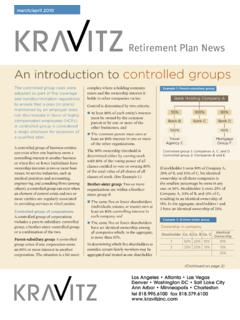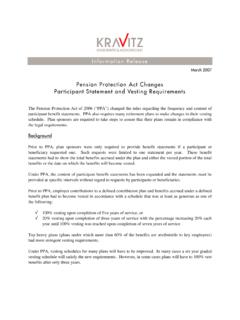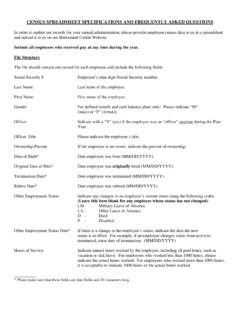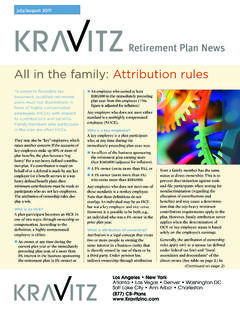Transcription of Back to basics: Record retention - Kravitz, Inc.
1 It s a well-known fact that the Employee Retirement Income Security Act of 1974 (ERISA) established specific reporting and disclosure obligations for qualified retirement plans. Less well known but equally important is the fact that ERISA also spells out how long a plan sponsor must retain plan documents and records that support those obligations. The topic of Record retention can be broken into three general areas: 1. What records should be kept? 2. How long should they be kept? 3. How should they be archived? The short answers are:1. All records that support the plan s annual reporting (Form 5500) and disclosure requirements should be retained. 2. All plan related materials and records should be kept for a period of at least six years after the date of filing an ERISA-related return or report. 3. Records should be preserved in a manner and format (electronic or otherwise) that permit ready retrieval.
2 Ultimately, the responsibility to retain these records lies with the plan adminis-trator (the employer). While it is fairly common for a plan sponsor to contract with outside service providers who may provide certain reports and prepare the plan s Form 5500 filing, the plan admin-istrator is ultimately responsible for retaining adequate records to support the reports and filings. In addition, the Department of Labor (DOL) requires employers to maintain records sufficient to determine the amount of benefits accrued by each plan participant. Plan documentsERISA requires that plan administrators retain the following types of plan docu-ments: original signed and dated plan document and all original signed and dated plan amendments (dates and sig-natures should be easily visible), a copy of the plan s most recent IRS approval letter, and copies of Form 5500.
3 Form 5500 can follow the six-year retention rule. However, actual plan documents and amendments should be maintained from adoption until after the plan is terminated. While plans are routinely restated every five or six years, the IRS may, on occasion, go back beyond the prior restatement. It is important to remember, especially when switching vendors, that it s the employer s responsibility to maintain these documentsReports that support these documents should also be retained, including finan-cial reports, Trustees reports, journals, ledgers, certified audits, investment analyses, balance sheets, income and expense statements, corporate/partner-ship income-tax returns (to reconcile deductions), documentation supporting may/june 2014(Continued on page 2)Back to basics: Record retentionLos Angeles New YorkAtlanta Las Vegas Denver Washington DCSalt Lake City Ann Arbor Charleston(877) Plan Newsthe trust s ownership of the plan s assets, evidence of the plan s fidelity bond (if applicable), and copies of nondiscrimination and coverage test that supports decisions made by the plan administrator should also be retained, including copies of all corporate/partnership actions and administrative committee actions relating to the and other dataPayroll records used to determine participant eligibility and contributions (including details that support an exclusion from participation) should be retained.
4 Records that establish hours of service data must also be kept to demonstrate the determination of allocations and vesting. Note: It is critical that sponsors keep complete census data, not just data on those who are eligible to of all communications provided to participants and/or beneficiaries should be retained (including Summary Plan Descriptions, Summaries of Material Modifications, and any-thing else describing the plan). Copies should also be kept of other forms of communication (including notices, disclosures, webinars, slides, and e-mails). Recent plan audits have raised issues regarding whether all eligible employees who chose not to defer actually had the option of participating in their 401(k) plan. Records should be maintained to prove plan participa-tion was made available to all eligible forms and tax reportingFor plan audit purposes, documentation must be kept to dem-onstrate that participant transactions are conducted in accor-dance with plan document provisions.
5 Examples include copies of all documents relating to plan loans, withdrawals, and distributions (including cop-ies of spousal consents) and plan distribution records (including Forms 1099-R).Duration of storageAs noted above, these records generally should be kept for a period of six years after the date of the filing to which they relate. However, good practice suggests that certain records be kept for the life of the plan specifically all plan documents dating from the plan s inception. The thicker the paper trail, the easier it will be for the plan to respond to an inquiry from a governmental agency or a request for informa-tion from a plan participant. Records must be kept in such a way that they can be readily retrieved. To the extent that records are lost, stolen, or destroyed before the expiration of the six-year period, the plan administrator will be required to recreate the records, unless doing so would cost an excessive or unreasonable amount.
6 Electronic storageAccording to DOL regulations, electronic media may be used to comply with the Record retention requirements provided the recordkeeping system meets the following requirements: There are reasonable controls to ensure the accuracy of the records; It is capable of indexing, retaining, preserving, retrieving, and reproducing the electronic records. The retrieval issue becomes more interesting as equipment is updated and upgraded. For example, records retained on microfiche or floppy disks may fail this test if there is no way to read them; Records can be readily converted into legible paper copies; It is not subject to restrictions that would inappropriately limit the access to the records. What to do with paper recordsMost original paper records may be disposed of after they are transferred to an electronic recordkeeping system, pro-vided the recordkeeping system complies with the above requirements.
7 It is important to note that originals may not be discarded if they have legal significance or inherent value ( , notarized documents, insurance contracts, stock certifi-cates, and documents executed under seal). ArchivingProper and complete archiving of plan records is essential. Due to advancements in tech-nology, many transactions do not take place on paper, which presents an added challenge to the Record -keeping requirements. Nonetheless, the plan s records should be periodi-cally reviewed, updated, and purged (only to the extent appropriate). This will be time well spent and serves double duty as an overall audit of the plan s operations. As a practical matter, plan sponsors may want to keep records for a longer period in case of legal actions from participant divorce actions (qualified domestic relations orders, or QDROs) or lawsuits brought by disgruntled to basics: Record retention (Continued from page 1)Cost and flexibility are two reasons employers might be interested in using leased employees.
8 Although leased employees are not common-law employees of the organization they are performing services for (the recipient employer), when certain conditions are met, the recipient employers must treat leased employ-ees as their regular employees for qualified plan coverage purposes. This article provides a basic overview of the circumstances under which an indi-vidual is considered a leased employee for qualified plan purposes. Leased employee: definitionThere are a number of specific rules that must be met for an individual to be con-sidered a leased employee. Specifically, the recipient employer must be paying for the individual s services; the services must be pursuant to an agreement between the recipient employer and a leasing organiza-tion; and the individual must perform ser-vices on a substantially full-time basis for at least one year.
9 Substantially full-time basis means that within a 12-month period, the individual completes the lesser of: 1,500 hours of service or 75% of the number of hours that are customarily performed by a regular employee in the specific position. (If this method is used, an individual must be credited with at least 500 hours to be considered substantially full-time, even if 75% of the number of hours customar-ily performed would be less than 500.)In addition, services must be performed under the primary direction or control of the recipient employer, and the individual must be a common-law employee of the leasing plans and leased employeesOnce the above definition has been satis-fied, the recipient employer must treat the leased employee as a regular employee for qualified plan purposes and credit the leased employee for all service during the period the individual is a leased employee, including the qualifying one-year period.
10 The leased employee will generally be provided with retirement plan benefits in the recipient employer s plan, although sometimes there are arrangements whereby the recipient employer will pay the leasing employer an amount equal to the benefit provided under the leasing employer s plan. Limited exceptionThe Internal Revenue Service (IRS) pro-vides a limited safe harbor that permits a recipient employer to exclude leased employees from plan coverage if: Leased employees do not constitute more than 20% of the recipient employer s nonhighly compensated employee work force, and The leasing organization maintains a nonintegrated money purchase plan that makes a contribution of at least 10% of compensation for the leased employees. Such a plan must provide the leased employees with immediate eligibility and full vesting upon plan entry. Exclusion by plan provision Some employers may hesitate to use leased employees because of potential administrative complexities regarding their retirement plan.















